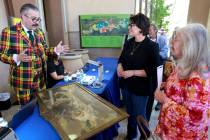Utah Shakespeare Festival brings ‘Romeo and Juliet’ to schools, general public
With great power comes great responsibility.
Those words to live by don't apply to Spider-Man alone.
Just ask those responsible for the Utah Shakespeare Festival's annual Shakespeare-in-the-Schools tour.
The three-month, 14-week tour - which presents "Romeo & Juliet" to more than 25,000 students in Nevada, Utah and Arizona - began its 12-day College of Southern Nevada residency Monday after stops in, among other places, Logandale and Henderson.
More than 3,600 area high school students are scheduled to see a 75-minute version of "Romeo & Juliet" this week and next. (Discussions and workshops follow the school performances.)
General audiences, however, will get in on the act Friday and Saturday when the troupe presents two public performances of "Romeo and Juliet" in the college's Nicholas J. Horn Theatre.
Although William Shakespeare's beloved tale of star-crossed lovers has been cut to fit an abbreviated running time, "we didn't dumb it down, or cheese it up, for high school" audiences, insists director John Maclay , adding that "our goal is to create a piece of art that plays to all markets" - including members of the general public.
Recent preview performances in the Utah Shakespeare Festival's hometown, Cedar City, demonstrates the production's impact on both target audiences, Maclay notes.
A daytime preview found middle- and high-school students in the audience, with the general public attending the evening show.
"It was fascinating," Maclay recalls, noting their "different reactions" to certain scenes, although "it was really clear that both audiences were sincerely affected by it."
Of course, "Romeo and Juliet" ranks as the ideal William Shakespeare play "to take into high schools," the director says, because "it's incredibly accessible."
After all, he points out, it's about teenagers.
In addition, "when we go into a school, maybe the students are seeing their first Shakespeare," making it "important that they see themselves in those characters," Maclay said.
Reaching a new generation of audiences makes the annual Shakespeare-in-the-Schools tour "our favorite piece of programming that we have here at the festival, as well as our most important," comments Brian Vaughn, the festival's co-artistic director, who notes that "through these plays we usher in the next generation of playgoers that will keep our craft vital and alive."
Maclay believes today's audiences can see themselves in the play's characters - even when "Romeo and Juliet" productions set the tale in Shakespeare's day, the Elizabethan era.
Shakespeare's "description of humanity weathers all periods," Maclay says.
Even so, this production boasts a more contemporary look, with a hint of Asian influence in its modern setting.
Costume designer Christina Leinicke uses color to differentiate between enemy clans in "Romeo and Juliet": teal for Romeo's family, the Montagues, and gold for Juliet's, the Capulets.
And Ben Hohman's set design includes a bridge symbolizing the separation between the two feuding families - that is, until Romeo (played by Chris Klopatek ) and Juliet (Melisa Pereyra ) fall in the love, thereby bridging the gap. (Or trying to.)
Despite the production's more contemporary look, one "non-negotiable" element from the past remains: sword fights.
It's a setting that has its own rules, Maclay explains, with "contemporary clothing, but not technology. ... They're still wearing swords, they're still carrying lanterns."
The mix of classic and contemporary elements underlines the notion that "society has changed a great deal - but what makes us human has not," Maclay says.
The play's major themes also continue to resonate, he adds.
"One of the messages of the play is the futility and pointlessness of violence," Maclay says, adding that it's a message that "seems even more important" now, given "what's been happening" in contemporary society, including the current gun control debate.
Another theme, heightened by the production's rapid running time, is "that it's just going too fast" for the play's characters, he points out. When they react without pausing to ponder actions - and their consequences - everything "snowballs," Maclay says.
Cutting the play "really reinforces that idea" - along with "Romeo and Juliet's" overall impact.
"It's just exciting for young people to see it," Maclay says of the touring production. "It's a huge responsibility" involved in "showing them their first Shakespeare. If you can make it immediate, human and inspiring, you've made a Shakespeare audience member for life."
Contact reporter Carol Cling at ccling@reviewjournal.com or 702-383-0272.
PREVIEW
What: "Romeo and Juliet"
When: 7:30 p.m. Friday, 2 p.m. Saturday
Where: Nicholas J. Horn Theatre, College of Southern Nevada, 3200 E. Cheyenne Ave., North Las Vegas
Tickets: $10-$12 (702-651-5483)






















